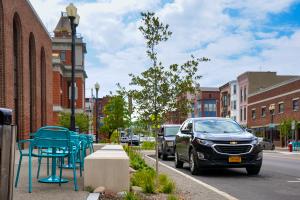Landscape Architecture: A Pivotal Practice
Landscape architects employ site analysis, planning, design, management, and stewardship to safeguard the public’s health, safety, and welfare. This work creatively utilizes science, art, and technology to seamlessly blend natural features with the built environment. The impact of landscape architects can be easily identified in public parks, streetscapes, waterfront amenities, and residential designs. However, the profession’s scope extends beyond these familiar domains to encompass community planning, climate resiliency, green infrastructure, universal design, and habitat restoration.
The American Society of Landscape Architecture was founded in 1899 with licensure beginning in the 1960s, and in July of 2023, The US Department of Homeland Security designated Landscape Architecture as a STEM discipline. This designation recognizes that landscape architecture requires knowledge and use of science, technology, engineering, and mathematics daily. From the understanding of the microbial composition of soils, nutrient exchanges that preserve and enhance our urban canopy and biodiverse vegetative communities, knowledge of hydrologic cycles, and implementing designs with climate action in mind, the STEM behind the profession has driven and will continue to drive Landscape Architects as leaders in the field.
Though occasionally mistaken as merely gardening, planting, or land stewardship, the profession is much more complex. Landscape architecture is not just about creating parks and gardens, or incorporating more trees and plants, it goes beyond that to enhance communities, create safe and healthy outdoor spaces, incorporate inclusive and accessible options, and provide access to resources such as fresh food, public transportation, and recreation areas. Designs are approached holistically to help reduce the urban heat island effect, improve air quality, reduce greenhouse gas emissions, improve ecology, expand biodiversity, promote community and environmental resiliency, and address stormwater management through green infrastructure.

Landscape architects will often lead a project’s planning and design process and be critical members of multidisciplinary teams assembled to address specific design or research challenges and create innovative design solutions. Landscape architects also excel at developing community engagement strategies that promote collaborative and interactive approaches to planning and design. By researching the history, hearing the stories, and working with the community to develop their vision for the project, landscape architects are able to cultivate and create spaces that have positive impacts on society, culture, and the environment. This mindset and approach put landscape architects at the forefront of the conversation to address critical subjects such as climate action, resiliency, biodiversity, equity, and environmental justice.
At B&L, our Landscape Architects engage in a diverse range of projects spanning from Maine to the Mid-Atlantic, encompassing:
- Trails and Greenways
- Streetscapes and Complete Streets Improvements
- Site & Field Lighting Plans
- Site, Layout, Design, and Planting Plans
- Stormwater Management and Green Infrastructure Design
- Parks and Recreation Master Planning
- Design of Parks, Trails, and Open Space
- Waterfront Improvements
- Shoreline Management and Protection Strategies
- Coastal Resilience Design
- Active Transportation Plans
- Multi-modal Transportation and Feasibility Studies
- Athletic Facility Design
- Playgrounds and Splash Pads
Through every project, our team is focused on making our clients’ visions a reality and creating memorable and meaningful outdoor spaces.

April is World Landscape Architecture Month. During this month (and beyond), we celebrate the important role of landscape architecture in creating resilient, adaptive, healthy and beautiful places for all, we advocate for the profession and the significance of licensure, and we educate, support, and inspire the future landscape architects to excel as leaders in this field.
Want to learn more about Landscape Architecture? Please feel free to reach out to B&L’s Landscape Architects, Nicole Cleary, ASLA, PLA, or Kevin Grindle, ASLA, PLA.


